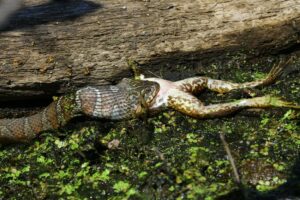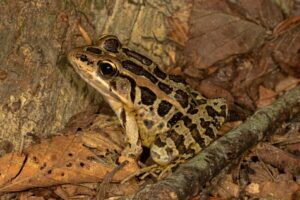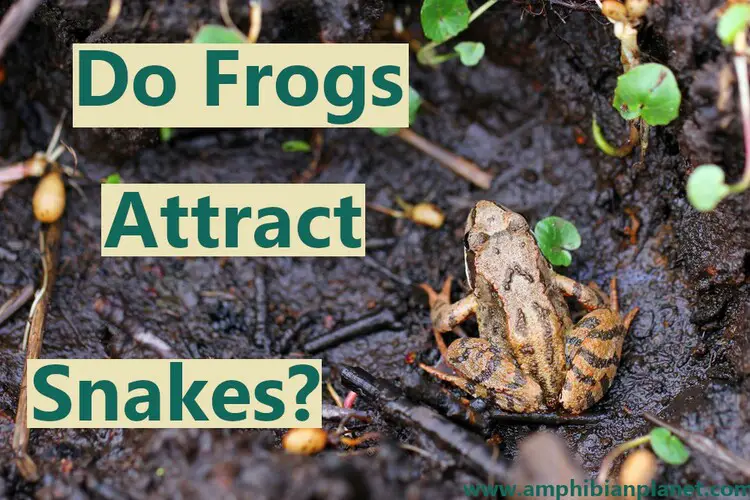Frogs are amphibians that love wet moist environments. For this reason, they are often attracted to gardens and yards with a pond. Even watering your lawn can attract any frogs that may be close by. But do frogs attract snakes?
In general, frogs do attract snakes. Frogs are one of the main prey species for many snakes around the world. For this reason, having frogs in your yard may attract hungry snakes looking for a meal.
That being said, it is important to note that having snakes in your yard is not always something to worry about. Some snake species such as garter snakes and rat snakes are generally harmless to humans and eat pests such as rodents and slugs.
Kingsnakes (which are also harmless to humans) are even known to eat venomous snakes such as copperheads and rattlesnakes – helping keep these potentially harmful snakes off your yard.
Why Do Frogs Attract Snakes?
Worldwide, many snakes primarily feed on small amphibians and rodents. For example, in North America, the primary food of the eastern hognose snake is toads.
In fact, Eastern hognose snakes are so specialized in eating toads, that they have large teeth in the back of their mouths to puncture inflated toads to make them easier to swallow.
Garter snakes are also heavily reliant on frogs, toads, salamanders, and newts as food. Asian Keelback snakes also very frequently eat frogs and their tadpoles.

There are even snakes that specialize in eating frog egg masses laid on leaves overhanging streams.
For this reason, snakes will be attracted to areas where they can find lots of frogs, rodents, and other small animals to prey on.
The more frogs, rodents, and other prey animals you have in your yard, the more snakes you will see in your yard.
Not All Frogs Are Defenseless When It Comes to Fending Off Hungry Snakes
To stop snakes (and other predators from eating them), many frogs, and toads can produce poisonous skin secretions that taste bad or are lethal to many predators.
For example, Cuban tree frogs and pickerel frogs produce foul-tasting poisonous skins when threatened, so some snakes will learn to leave them alone.

Still, even poisonous frogs are often eaten by some snake species. Northern water snakes and garter snakes have developed immunity to the secretions of pickerel frogs and are known to frequently eat these frogs.
Cuban tree frogs are also regularly preyed on by rat snakes and garter snakes.
Also, eastern hog-nosed snakes frequently eat highly poisonous toads with impunity, due to the resistance these snakes have to the toxins toads secrete.
12 Tips to Keep Frogs Out of Your Yard
If you want to stop snakes from coming into your yard, you have to make the area less attractive to them. One of the ways of doing this is to get rid of the “snake food” (prey animals) you have in your yard.
Here are a number of things you can do to keep frogs off your yard.
1. Cover Swimming Pools
Being amphibians, frogs are attracted to areas with water bodies where they can swim. It is important to cover your swimming pool when it is not in use. This will help discourage frogs from coming onto your property.
It will also protect the frogs as chlorine from the pool water can be very harmful or even lethal to them.
2. Consider Building a Small Fence Around Ponds in Your Yard
Unlike swimming pools, ponds housing fish and live plants need direct sunlight. This means they can not be covered up as swimming pools can.
Instead, you could try building a small fence around your ponds – that frogs cannot climb or hop over.
3. Raise Your Birdbaths and Keep Them Farther Away From Your Home
Bird baths close to the ground provide an excellent source of water for frogs to soak in.
If possible, raise your birdbaths to make them less accessible to frogs. Also, keep them farther away from your home.
4. Keep Your Grass Short
Tall grass provides the perfect cover for frogs and other amphibians to hide from predators. It also attracts bugs such as grasshoppers and other frog food. Keeping your grass short will discourage frogs from coming into your yard.
It will also make it easy to spot the frogs that do end up in your yard so you can get rid of them.
5. Clear Dead Leaves and Other dead Vegetation
Frogs love to hide under dead logs and leaf litter on the ground. Getting rid of these will keep frogs away because they will have fewer places to hide.
7. Store Firewood, Compost Piles, and Other Types of Debris Away From Your Home
Frogs love to hide under any cover they can find. Stacks or firewood and lubber are the perfect places for them to hide. Sometimes, they will even hibernate deep in compost piles to escape the freezing winter temperatures.
Store firewood, lumber, and other piles of debris away from your home.
8. Don’t Overwater Your Lawn
Frogs are amphibians that love moist environments where their skin won’t dry out. For this reason, over-watering your lawn will attract frogs to your yard.
Also, it will make the grass grow faster which means it will need to be mowed more often.
9. Use a Raised Water Bowl for Your Pets
If you have dogs, cats, or any other pets at home that spend lots of time outdoors, it’s a good idea to use a raised water bowl. This is to prevent frogs from easily accessing or getting into the water.
Also, remember to change the water every day so your pets do not get poisoned by any frogs or toads that do get into the water (pets can ingest frog or toad toxins by drinking water the amphibian soaked in).
10. Consider Installing a Fence
If you have an open yard in an area with lots of amphibians, inevitably, a few frogs will eventually end up on your property.
Install a fence and put a mesh screen around the outside of your fence. Bury the screen by at least 10cm and extend it by at least 50cm. This will help stop any frogs trying to come into your yard.
Some companies even make wildlife-specific fencing. You could easily find a “frog-proof fence” appropriate for your yard.
11. Be Vigilant During the Wetter Seasons of the Year
Frogs and other amphibians are most active in the wetter months when the temperatures are warm. Be alert during this time of the year and watch for any frogs that may end up in your yard.
Be extra alert in the very early morning hours, after dark, or after a rainstorm when amphibians are more likely to be active.
12. Fill Out Low-Lying Areas in Your Yard
After a rainstorm, take note of where puddles form in your yard. Use dirt or soil to fill these low-lying areas out.
All of the things mentioned above are just a few things that you should consider doing to keep frogs away from your yard.
Above all, you need to make sure that you inspect the yard on a consistent basis to get rid of any frogs that might be hiding or wandering about.
What Other Animals Attract Snakes?
Frogs and toads are not the only animals that attract snakes to your yard. Bird eggs, baby birds, slugs, snails, lizards, salamanders, newts, rats, mice, moles, and other small animals can attract snakes.
Almost any small animals that are small enough for snakes to catch and swallow whole, will attract snakes looking for a meal.
Some snake species may even be drawn to areas with fishponds where they can eat small fish.
Frequently Asked Questions (FAQS)
Do snakes eat tadpoles? In general, snakes do eat tadpoles. If a snake lives in an area where there is water, it will eat tadpoles when it gets the chance. Asian Keelback snakes, garter snakes, and ribbon snakes are known to be voracious tadpole eaters.
Do frogs keep snakes away? Large frog species such as bullfrogs are known to eat small Snakes. However, in the majority of situations, it is frogs that get preyed on by snakes, rather the other way around. For this reason, frogs generally do not keep snakes away. Rather, they attract them.
Do garden snakes eat frogs? Garden snakes will eat almost any small animals they can catch and swallow whole. If a hungry garden snake catches a small enough frog, it will eat it.
Conclusion
Now you know that having frogs in your yard may attract snakes. However, you should remember that not all snakes are bad to have around.
Some types of snakes are harmless to humans and help keep the population of rodents and other pests down. Also, snakes such as the kingsnake eat many venomous snakes, helping keep these potentially harmful snakes off your yard.


